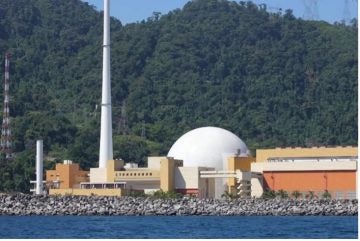
Brazil is expected to establish a permanent repository for low- and intermediate-level nuclear waste by early 2029. This facility store waste produced by NPPs, medical facilities, and the food industry, for centuries to come.
The repository will be executed by the the Nuclear Regulatory Authority (CNEN – Comissào National de Energia Nuclear – National Nuclear Energy Commission). It is a key component of the Nuclear and Environmental Technology Centre (Centena – Centro Tecnológico Nuclear e Ambiental) project. The centre will not only not only provide permanent storage for radioactive waste but also include support buildings for operational activities and facilities for research and technological development. The centre will also offer specialised training.
Currently, radioactive waste generated by the Almirante Alvaro Alberto NPP, which brings together the Angra 1 and Angra 2 plants, is stored in warehouses near the plants. This material, which includes contaminated tools and uniforms, is isolated in steel barrels and small containers before being transported to the Waste Management Centre (CGR – Centro de Gerenciamento de Residuos), a complex comprising three warehouses. Currently, it has the capacity to receive additional material until 2030.
Nuclear utility Eletronuclear said that if CNEN has not developed a solution by 2028, the company will seek an alternative on the NPP site either by building another facility or finding new storage technology.
The Centena facility will operate for 60 years and undergo monitoring for an additional 300 years after its closure. Clédola Cássia Oliveira de Tello, the technical coordinator of the Centena Project, explained that the facility will undergo several licensing phases before becoming operational. “The first phase relates to the site, the second to construction, and the final phase to operation,” she stated. The exact location of the Centena facility has not yet been announced. “Currently, the projected start of operations is late 2028 to early 2029,” de Tello said.
Segregation, characterisation, and treatment of radioactive waste is the responsibility of the waste-generating facility as is transportation to Centena. Upon arrival at Centena, documentation will be checked, and initial acceptance tests conducted. The consignment will then be directed to temporary storage, and a sample of the packages sent for radiochemical analyses. For disposal, the waste package will be placed in concrete containers according to a predetermined cargo composition. These containers will be filled with mortar and placed in the disposal modules.
Finally, when the module capacity is complete, the module will be sealed with mortar and a slab, in line with the multi-barrier concept. The successive barriers ensure sufficient isolation of the waste from the environment and limit potential releases of radioactive materials in the event of a failure or combinations of failures. The engineering barriers are designed to provide the complete confinement of the radionuclides present in the waste for hundreds of years.






